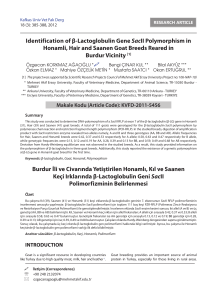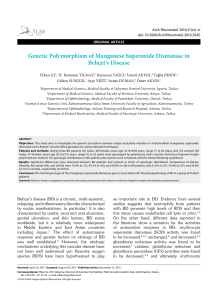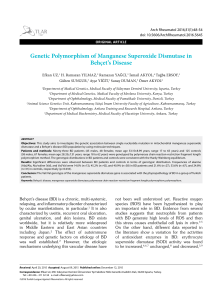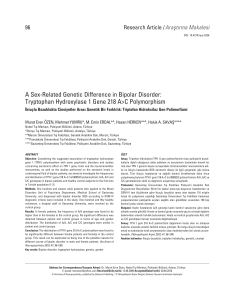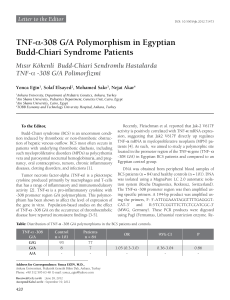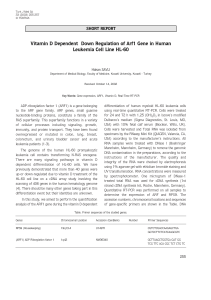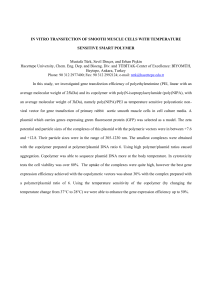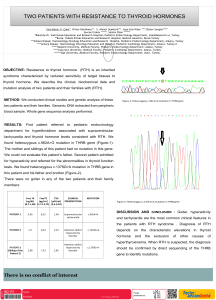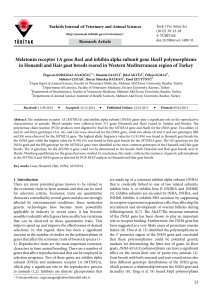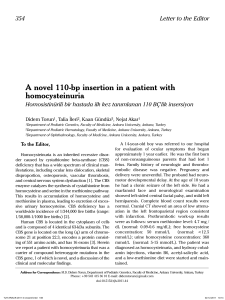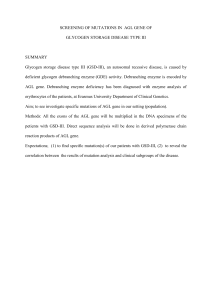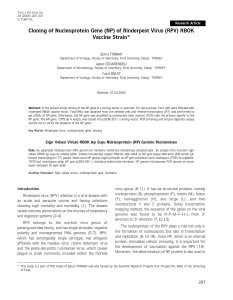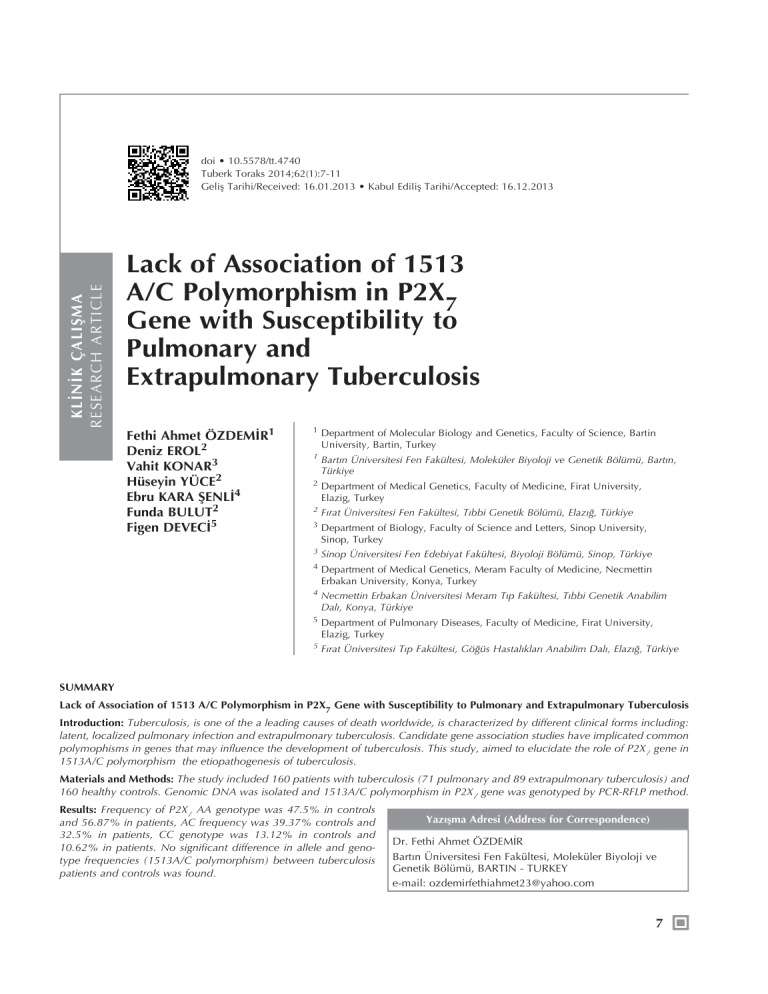
KLİNİK ÇALIŞMA
RESEARCH ARTICLE
doi • 10.5578/tt.4740
Tuberk Toraks 2014;62(1):7-11
Geliş Tarihi/Received: 16.01.2013 • Kabul Ediliş Tarihi/Accepted:
/
16.12.2013
Lack of Association of 1513
A/C Polymorphism in P2X7
Gene with Susceptibility to
Pulmonary and
Extrapulmonary Tuberculosis
Fethi Ahmet ÖZDEMİR1
Deniz EROL2
Vahit KONAR3
Hüseyin YÜCE2
Ebru KARA ŞENLİ4
Funda BULUT2
Figen DEVECİ5
1
Department of Molecular Biology and Genetics, Faculty of Science, Bartin
University, Bartin, Turkey
1
Bartın Üniversitesi Fen Fakültesi, Moleküler Biyoloji ve Genetik Bölümü, Barttın
n,
Türkiye
2
Department of Medical Genetics, Faculty of Medicine, Firat University,
Elazig, Turkey
2
Fırat Üniversitesi Fen Fakültesi, Tıbbi Genetik Bölümü, Elazığ, Türkiye
3
Department of Biology, Faculty of Science and Letters, Sinop University,
Sinop, Turkey
3
Sinop Üniversitesi Fen Edebiyat Fakültesi, Biyoloji Bölümü, Sinop, Türkiye
4
Department of Medical Genetics, Meram Faculty of Medicine, Necmettin
Erbakan University, Konya, Turkey
4
Necmettin Erbakan Üniversitesi Meram Tıp Fakültesi, Tıbbi Genetik Anabilim
m
Dalı, Konya, Türkiye
5
Department of Pulmonary Diseases, Faculty of Medicine, Firat University,
Elazig, Turkey
5
Fırat Üniversitesi Tıp Fakültesi, Göğüs Hastalıkları Anabilim Dalı, Elazığ, Türkkiyye
SUMMARY
Lack of Association of 1513 A/C Polymorphism in P2X7 Gene with Susceptibility to Pulmonary and Extrapulmonary Tuberculosis
ul
Introduction: Tuberculosis, is one of the a leading causes of death worldwide, is characterized by different clinical forms includ
ding:
latent, localized pulmonary infection and extrapulmonary tuberculosis. Candidate gene association studies have implicated common
mm
polymophisms in genes that may influence the development of tuberculosis. This study, aimed to elucidate the role of P2X7 gene
n in
1513A/C polymorphism the etiopathogenesis of tuberculosis.
Materials and Methods: The study included 160 patients with tuberculosis (71 pulmonary and 89 extrapulmonary tuberculosis)) and
160 healthy controls. Genomic DNA was isolated and 1513A/C polymorphism in P2X7 gene was genotyped by PCR-RFLP method.
th
Results: Frequency of P2X7 AA genotype was 47.5% in controls
and 56.87% in patients, AC frequency was 39.37% controls and
32.5% in patients, CC genotype was 13.12% in controls and
10.62% in patients. No significant difference in allele and genotype frequencies (1513A/C polymorphism) between tuberculosis
patients and controls was found.
Yazışma Adresi (Address for Correspondence)
Dr. Fethi Ahmet ÖZDEMİR
Bartın Üniversitesi Fen Fakültesi, Moleküler Biyoloji ve
Genetik Bölümü, BARTIN - TURKEY
e-mail: ozdemirfethiahmet23@yahoo.com
7
Lack of Association of 1513 A/C Polymorphism in P2X7 Gene with
Susceptibility
p
y to Pulmonaryy and Extrapulmonary
p
y Tuberculosis
Conclusion: The results suggest that 1513A/C polymorphism of P2X7 gene is not associated with pulmonary and extrapulmonary
tuberculosis in the Eastern Turkey.
Key words: Tuberculosis, P2X7, polymorphism
ÖZET
Pulmoner ve Ekstrapulmoner Tüberkülozlu Hastalarda P2X7 Genindeki 1513 A/C Polimorfizmin Hastalıkla İlişkisinin Olmaması
Giriş: Latent, pulmoner ve ekstrapulmoner şeklinde farklı klinik formları olan tüberküloz, dünya genelinde ölüme sebebiyet veren
hastalıkların en önemlilerinden biridir. Aday genlerle yapılan çalışmalarda yaygın polimorfizmlerin tüberkülozun gelişmesinde etkili
olabileceği sonucuna varılmıştır. Bu çalışmada P2X7 genindeki 1513 A/C polimorfizminin tüberkülozun etyopatogenezisindeki rolünün ortaya çıkarılması amaçlanmıştır.
Materyal ve Metod: Bu çalışma 160 tüberkülozlu (71 pulmoner tüberkülozlu ve 89 ekstrapulmoner tüberkülozlu) 160 da sağlıklı
bireyi kapsamaktadır. Genomik DNA izolasyonu gerçekleştirildikten sonra P2X7 genindeki 1513 A/C polimorfizmi PCR-RFLP metoduyla genotiplendirildi.
Bulgular: AA genotipinin frekansı kontrol grubunda %47.5, hastalarda %56.87, AC genotipinin frekansı kontrol grubunda %39.37,
hastalarda %32.5, CC genotipinin frekansı kontrol grubunda %13.12, hastalarda %10.62 olarak saptandı. Hastalar ile kontrol grubunun allel ve genotip frekansları arasında anlamlı bir farklılık bulunamadı.
Sonuç: Sonuçlarımız Türkiye’nin doğu bölgesinde P2X7 genindeki, 1513 A/C polimorfizminin pulmoner ve ekstrapulmoner tüberküloz hastalığıyla ilişkisinin olmadığını gösterdi.
Anahtar kelimeler: Tüberküloz, P2X7, polimorfizm
INTRODUCTION
Tuberculosis is a major cause of morbidity and mortality worldwide, especially in Asia and Africa.
Genetic variability, combined with environmental
factors, are shown to contribute to the risk of developing active tuberculosis (1). Some patients have
identifiable risk factors such as diabetes mellitus,
malnutrition, human immunodeficiency virus (HIV)
infection or immunosuppressive therapy; however
many patients exhibit none of these clinical risk factors (2).
Some genetic variations such as Mendelian-inherited
mutations in the genes encoding interferon-gamma
(IFN-γ), interleukin-12, and signal transducers are
rare and are associated with severe mycobacterial
infection. Recently some researchers have reported
that polymorphism in IFN-γ and MCP-1 genes were
associated with an increased risk of developing
active tuberculosis in some Tunisian patients (3).
Other genetic variations such as polymorphisms in
the genes encoding human leukocyte antigen (HLA),
P2X7 receptor, the solute carrier family 11 member
a1 protein (SLC11A1, formerly known as NRAMP1),
and vitamin D3 receptor (VDR), which occur more
commonly, are considered to account for the susceptibility of the general population to tuberculosis (4,5).
Human P2X7, which encodes the P2X7 receptor, has
been cloned and mapped to the human chromosome
12q24 and linked to tuberculosis susceptibility (6).
8
Tuberk Toraks 2014;62(1):7-11
; ( )
P2X7 is highly polymorphic and several single nucleotide polymorphisms (SNPs) that lead to the loss of
receptor function have been identified (7,8). The
most common is the 1513A→C polymorphism
because glutamic acid at position 496 changes to
alanine. The function of the P2X7 receptor in macrophages from subjects homozygous for the 1513C
allele is ablated, and the function of the P2X7 receptor in macrophages from heterozygous subjects is
significantly impaired.
The aim of this study was to determine the genotype
and allelic distribution and possible link to susceptibility to tuberculosis of P2X7 1513A→C polymorphism in the Eastern Turkey.
MATERIALS and METHODS
Patients and Control Group
The study was approved by the ethics committee of
Firat University Medical Faculty. A total of 160
patients with active tuberculosis (71 pulmonary
tuberculosis, 89 extrapulmonary tuberculosis patients;
with mean age 37.43 ± 14.58 years) were recruited
from those who were treated and followed up in the
Pulmonary Diseases Department of the Firat
University Hospital, Turkey. As healthy controls, age,
sex and origin-matched 160 unrelated selected
healthy subjects (mean age 39.27 ± 13.84 years).
Patients were recruited between September 2009 and
May 2011 and were selected after confirmation of the
Özdemir FA,, Erol D,, Konar V,, Yüce H,, Kara ŞŞenli E,, Bulut F,, Deveci F.
infection
f
according to the criteria defined
f
by the
American Thoracic Society (9). The diagnosis of
active pulmonary tuberculosis was based on clinical
examination and the presence of the Mycobacterium
tuberculosis strain in sputum smears and cultures on
Lowenstein-Jensen and Coletsos media. Active
extrapulmonary tuberculosis was identified by histological examination (granulomatous formations) of
data and confirmed by conventional bacteriological
methods.
Genotype Analysis
Peripheral blood samples were drawn from all of the
participants, and were taken into tubes containing
ethylenediamine tetraacetate (EDTA) and DNA was
extracted and stored at -20°C until analysis of the
P2X7 polymorphism.
Genomic DNA was prepared from 300 μL of fresh
blood peripheral blood mononuclear cells using a
Wizard Genomic DNA Purification Kit (Promega
Corporation, Madison, WI) according to the manufacturer’s recommendations. Afterwards the samples
were quantified using a Nanodrop spectrophotometer (UV-Visible NanoDrop 1000, Thermo Fisher
Scientific Inc.) and standardized to 50 ng μL-1.
Aliquots were stored at -20°C for further genotyping.
The 1513A→C SNP was genotyped by PCR-restriction
fragment length polymorphism (RFLP) with the following primers: 5’-AGA CCT GCG ATG GAC TTC
ACA G-3’ (forward) and 5’-AGC GCC AGC AAG GG
CTC-3’ (reverse) (10). The PCR conditions were: initial
denaturation at 95°C for 5 minutes; 36 cycles of 95°C
for 30 seconds, 36 cycles of 66.3°C for 30 seconds,
36 cycles of 72°C for 40 seconds, and final elongation
at 72°C for 7 minutes. The PCR products were digested at 37°C for 4 hours with 5.0 U of HaeII (Promega).
The digested products were run on a 3% agarose gel
and visualized with 10 ng/mL ethidium bromide.
Statistical Analysis
Statistical analyses were carried out using SPSS software version 16 (SPSS Inc. Chicago IL USA). The
genotype distribution was tested for Hardy-weinberg
equilibrium using chi-square test in tuberculosis
patients and controls. The distributions of P2X7 polymorphism between tuberculosis patients and healthy
controls were compared using the Fisher’s exact test.
p< 0.05 was considered significant.
RESULTS and DISCUSSION
Genotypes and alleles frequencies of the 1513A→C
polymorphism of P2X7 gene in tuberculosis patients
and controls are shown in the Table 1.
The frequency of the 1513A allele in the tuberculosis
patients was 0.27, where as that of 1513C was 0.73,
and no significant differences were noted in comparison with the frequencies in the case of the control
subjects (p> 0.05, Table 1). Analysis of genotypic
distribution using chi-square test revealed no significant difference between the two groups (p> 0.05,
Table 1). Moreover, no significant associations were
found between the genotypic or the allelic distributions and pulmonary or extrapulmonary tuberculosis.
This study was undertaken to gain insight into the
role of the human P2X7 receptor gene in the susceptibility to tuberculosis in the Eastern Turkey. Areas off
inflamed tissue such as tuberculosis granulomata
contain numerous monocytes, macrophages and
high local concentrations of ATP (released from
dying and activated cells) and pro-inflammatory
cytokines (11). It is possible that the ATP- linked P2X7
effector pathway may contribute to host immunity off
M. tuberculosis.
There is substantial evidence that show host genetic
factors are important in determining susceptibility to
mycobacteria (12,13). To the best of our knowledge,
this is the first study investigating the association
between P2X7 genetic polymorphisms and the sus-
Table 1. Genotype and allele frequency of the 1513A→C polymorphism of P2X7 in patients and controls
Genotype
Subjects (n)
Allele
AA (%)
AC(%)
CC(%)
p
A (%)
C (%)
Control (160)
76 (47.50%)
63 (39.37%)
21 (13.12%)
Patients (160)
91 (56.87%)
52 (32.5%)
17 (10.62%)
0.244
Pulmonary TB (71)
44 (61.97%)
18 (25.35%)
9 (12.67%)
Extrapulmonary TB (89)
47 (52.80%)
34 (38.20%)
8 (8.98%)
p
HWE (P)*
67
33
27
73
0.10
0.028
0.093
75
25
0.10
0.0053
0.553
28
72
0.275
0.607
0.176
TB: Tuberculosis * HWE (P) is the significance of correspondence to Hardy-Weinberg proportions according to chi-square test.
Tuberk Toraks 2014;62(1):7-11
;
9
Lack of Association of 1513 A/C Polymorphism in P2X7 Gene with
Susceptibility
p
y to Pulmonaryy and Extrapulmonary
p
y Tuberculosis
ceptibility to pulmonary and extrapulmonary tuberculosis in the Eastern Turkey.
Several SNPs in the P2X7 gene that affect the function
of this receptor have been described. The more relevant SNPs of P2X7 reported correspond to the
1513A/C that affects the carboxy terminal tail and
leads to a loss of receptor function as assessed by
ATP induced Ca2+ ethidium bromide influx and IL-1β
release (14-18). Previous studies have shown that
macrophages from individuals homozygous for the
1513C loss of function allele have complete loss of
receptor function while individual heterozygous for
this polymorphism still maintain 50% function to kill
intracellular parasites such as M. tuberculosis or T.
gondiii after exposure to ATP compared with macrophages from individuals with the 1513A wild type
allele (17,18).
This study indicates that there is no risk between
1513A/C polymorphism in the P2X7 gene and tuberculosis disease in the Eastern Turkey. These results
are in agreement with previously reported data in an
Australian Vietnamese population and a Chinese
Han population (17,19). It was reported in other studies in Mexicans, Russians and Tunisians an association was found between the 1513A/C polymorphism
and susceptibility to active tuberculosis (10,20,21).
The heterogenity of the results reported by these
studies could be related to one or more of the following parameters: (a) the ethnic origin of patients. For
example, it has been reported that ethnic-specific
genetic variations may influence host immunity to
tuberculosis, causing different tuberculosis susceptibilities (22). In this setting, among control subjects,
the prevalence of the 1513C loss of function allele
was 7.6% in a Gambian population, 13% in a
Russian Slavic population, 17% in a Tunisian population, 19% in a Mexican population, 20.6% in a
Vietnamese population and 33% in Turkish population (the present study); (b) Sample size and study
design which may affect statistical calculations; (c)
As genetic susceptibility to tuberculosis is polygenic,
the other described functional SNPs occurring in the
P2X7 gene may be associated with susceptibility to
active tuberculosis (10,17,20-23). Further studies are
needed to investigate whether this functional polymorphism is associated with a risk of developing
active tuberculosis.
Our results indicate that the 1513A/C polymorphism
of P2X7 are not associated with an increased susceptibility to M. tuberculosis infection in this population.
Because host susceptibility to tuberculosis is likely to
10
Tuberk Toraks 2014;62(1):7-11
; ( )
be under polygenic control, and the risks attributable
to each polymorphism is modest, the precise
mechanism(s) of underlying susceptibility or protection, as well as its possible clinical relevance,
remains an interesting topic to be explored further.
ACKNOWLEDGEMENT
This study was sponsored by Scientific Research
Projects Unit (FUBAP) of the Firat University (Project
no: FF.10.01).
CONFLICT of INTEREST
None declared.
REFERENCES
1. Cooke GS, Hill AV. Genetics of susceptibility to human
infectious disease. Nat Rev Genet 2001;2:967-77.
2. Barnes DS. Historical perspectives on the etiology of tuberculosis. Microbes Infect 2000;2:431-40.
3. Ben-Selma W, Harizi H, Bougmiza I, Hannachi N, Kahla
IB, Zaieni & Boukadida J. Interferon gamma +874 T/A
polymorphism is associated with susceptibility to active
pulmonary tuberculosis development in Tunisian patients.
DNA Cell Biol 2011;2011:379-87. DOI: 10.1089/
dna.2010.1157.
4. Döffinger R, Dupuis S, Picard C, Fieschi C, Feinberg J,
Barcenas- Morales G & Casanova JL. Inherited disorders of
IL-12- and IFN gamma-mediated immunity: a molecular
genetics update. Mol Immunol 2001;38:903-9.
5. Bellamy R. Susceptibility to mycobacterial infections: the
importance of host genetics. Genes Immun 2003;4:4-11.
6. Buell GN, Talabot F, Gos A, Lorenz J, Lai E, Morris MA &
Antonarakis SE. Gene structure and chromosomal localization of the human P2X7 receptor. Receptor Channel
1998;5:347-54.
7. Fernando SL, Saunders BM, Sluyter R, Skarratt KK, Wiley JS
& Britton WJ. Gene dosage determines the negative effects
of polymorphic alleles of the P2X7 receptor on adenosine
triphosphate-mediated killing of mycobacteria by human
macrophages. J Infect Dis 2005;192:149-55.
8. Shemon AN, Sluyter R, Fernando SL, Clarke AL, Dao-Ung
LP, Skarratt KK, et al. A Thr357 to Ser polymorphism in
homozygous and compound heterozygous subjects causes
absent or reduced P2X7 function and impairs ATP-induced
mycobacterial killing by macrophages. J Biol Chem
2006;281:2079-86.
9. American Thoracic Society. Diagnostic standards and classification of tuberculosis in adults and children. Am J Resp
Crit Care 2000;161:1376-95.
10. Nino-Moreno P, Portales-Perez D, Hernandez-Castro B,
Portales-Cervantes L, Flores-Meraz V, Baranda L, et al. P2X7
and NRAMP1/SLC11 A1 gene polymorphism in Mexican
Özdemir FA,, Erol D,, Konar V,, Yüce H,, Kara ŞŞenli E,, Bulut F,, Deveci F.
metsizi patients with pulmonary tuberculosis. Clin Exp
Immunol 2007;148:469-77.
11. Solini A, Chiozzi P, Morelli A, Fellin R, Di Virgilio F. Human
primary fibroblasts in vitro Express a purinergic P2X7 receptor coupled to ion fluxes, microvesicle formation and IL-6
release. J Cell Sci 1999;112:297-305.
12. Marquet S, Schurr E. Genetics of susceptibility to infectious
diseases: tuberculosis and leprosy as examples. Drug
Metab Dispos 2001;29:479-83.
13. Casanova JL, Abel L. Genetic dissection of immunity to
mycobacteria: the human model. Annu Rev Immunol
2002;20:581-620.
18. Lees MP, Fuller SJ, McLeod R, Boulter NR, Miller CM,
Zakrzewski AM, et al. P2X7 receptor-mediated killing of
an intracellular parasite, Toxoplasma gondii, by human
and murine macrophages. J Immunol 2010;184:7040-6.
19. Xiao J, Sun L, Jiao W, Li Z, Zhao S, Li H, et al. Lack of association between polymorphisms in the P2X7 gene and
tuberculosis in a Chinese Han population. FEMS Immunol
Med Mic 2009;55:107-11.
20. Mokrousov I, Sapozhnikova N, Narvskaya O. Mycobacterium tuberculosis coexistence with humans: making an
imprint on the macrophage P2X7 receptor gene? J Med
Microbiol 2008;57:581-4.
14. Gu BJ, Zhang W, Worthington RA, Sluyter R, DAo-Ung P,
Petrou S, et al. A Glu-496 to Ala polymorphism leads to
loss of function of the human P2X7 receptor. J Biol Chem
2001;276:11135-42.
21. Ben-Selma W, Ben-Kahla I, Boukadida J, Harizi H.
Contribution of the P2X7 1513A/C loss of function polymorphism to extrapulmonary tuberculosis susceptibility in
Tunisian populations. FEMS Immunol Med Mic: 2011:1-8.
DOI:10.1111/j.1574-695X.2011.00824.x.
15. Saunders BM, Fernando SL, Sluyter R, Britton WJ, Wiley JS.
A loss of function polymorphism in the human P2X7 receptor abolishes ATP mediated killing of mycobacteria. J
Immunol 2003;171:5442-6.
22. Möller M, Hoal EG. Current findings, challenges and novel
approaches in human genetic susceptibility to tuberculosis.
Tuberculosis 2010;90:71-83.
16. Sluyter R, Dalitz JG, Wiley JS. P2X7 receptor polymorphism
impairs extracellular adenosine 5’-triphosphate induced
interleukin-18 release from human monocytes. Genes
Immun 2004;5:588-91.
23. Li CM, Campbell SJ, Kumararatne DS, Bellamy R, Ruwende
C, McAdam KP, et al. Association of a polymorphism in the
P2X7 gene with tuberculosis in a Gambian population. J
Infect Dis 2002;186:1458-62.
17. Fernando SL, Saunders BM, Sluyter R, Skarratt KK, Goldberg
H, Marks GB, et al. A polymorphism in the P2X7 gene
increases susceptibility to extrapulmonary tuberculosis. Am
J Resp Crit Care 2007;175:360-6.
Tuberk Toraks 2014;62(1):7-11
;
11

